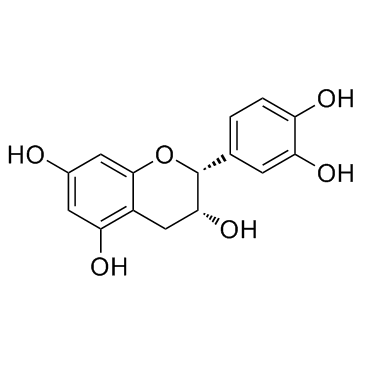Epicatechin

Epicatechin structure
|
Common Name | Epicatechin | ||
|---|---|---|---|---|
| CAS Number | 490-46-0 | Molecular Weight | 290.268 | |
| Density | 1.6±0.1 g/cm3 | Boiling Point | 630.4±55.0 °C at 760 mmHg | |
| Molecular Formula | C15H14O6 | Melting Point | 240 °C (dec.)(lit.) | |
| MSDS | Chinese USA | Flash Point | 335.0±31.5 °C | |
| Symbol |

GHS07 |
Signal Word | Warning | |
|
Green tea polyphenol (-)-epigallocatechin-3-gallate triggered hepatotoxicity in mice: responses of major antioxidant enzymes and the Nrf2 rescue pathway.
Toxicol. Appl. Pharmacol. 283(1) , 65-74, (2015) (-)-Epigallocatechin-3-gallate (EGCG), a constituent of green tea, has been suggested to have numerous health-promoting effects. On the other hand, high-dose EGCG is able to evoke hepatotoxicity. In the present study, we elucidated the responses of hepatic ma... |
|
|
Identification of Vitis vinifera L. grape berry skin color mutants and polyphenolic profile.
Food Chem. 194 , 117-27, (2015) A germplasm set of twenty-five grapevine accessions, forming eleven groups of possible berry skin color mutants, were genotyped with twelve microsatellite loci, being eleven of them identified as true color mutants. The polyphenolic profiling of the confirmed... |
|
|
Bi-layer composite dressing of gelatin nanofibrous mat and poly vinyl alcohol hydrogel for drug delivery and wound healing application: in-vitro and in-vivo studies.
J. Biomed. Nanotechnol. 9(9) , 1495-508, (2013) Present investigation involves the development of a bi-layer dressing of gelatin nanofibrous mat loaded with epigallocatechin gallate (EGCG)/poly vinyl alcohol (PVA) hydrogel and its in-vivo evaluation on full-thickness excision wounds in experimental Wistar ... |
|
|
Physicochemical characterisation of four cherry species (Prunus spp.) grown in China.
Food Chem. 173 , 855-63, (2014) The physicochemical characteristics of four cherry species (Prunus avium, Prunus cerasus, Prunus pseudocerasus and Prunus tomentosa) were evaluated. Inter-species variability was greater than intra-species differences. Glucose and fructose were the main sugar... |
|
|
Pine bark and green tea concentrated extracts: antioxidant activity and comprehensive characterization of bioactive compounds by HPLC-ESI-QTOF-MS.
Int. J. Mol. Sci. 15(11) , 20382-402, (2014) The consumption of polyphenols has frequently been associated with low incidence of degenerative diseases. Most of these natural antioxidants come from fruits, vegetables, spices, grains and herbs. For this reason, there has been increasing interest in identi... |
|
|
Effect of chocolate and Propolfenol on rabbit spermatogenesis and sperm quality following bacterial lipopolysaccharide treatment.
Syst. Biol. Reprod. Med. 60(4) , 217-26, (2014) The aims of the study were to evaluate the effects of chocolate and propolis-enriched diets on rabbit spermatogenesis, sperm motility, and ultrastructure following bacterial lipopolysaccharide (LPS) treatment. Thirty-two New Zealand White rabbits were divided... |
|
|
Effects of malted and non-malted whole-grain wheat on metabolic and inflammatory biomarkers in overweight/obese adults: a randomised crossover pilot study.
Food Chem. 194 , 495-502, (2015) Metabolic dysfunction in obesity may be attenuated by whole-grain intake, which has been attributed to synergistic actions of bioactive compounds. Germination/malting may increase grain bioactives, including polyphenols, however biological effects compared wi... |
|
|
Antioxidant comparative effects of two grape pomace Mexican extracts from vineyards on erythrocytes.
Food Chem. 194 , 1081-8, (2015) Maceration and Soxhlet methods were used to obtain methanol extracts from a Mexican grape (Ruby Cabernet) pomace and the biological activity and phenolic profiles were compared. The antioxidant capacity was used to evaluate the mechanism of action, using a ph... |
|
|
Investigating the potential of under-utilised plants from the Asteraceae family as a source of natural antimicrobial and antioxidant extracts.
Food Chem. 161 , 79-86, (2014) Antimicrobial properties of ethanol and water extracts from eight Asteraceae species were investigated against three Gram positive (Staphylococcus aureus, MRSA and Bacillus cereus) and two Gram negative (Escherichia coli and Salmonella typhimurium) bacterial ... |
|
|
Curcumin and epigallocatechin gallate inhibit the cancer stem cell phenotype via down-regulation of STAT3-NFκB signaling.
Anticancer Res. 35(1) , 39-46, (2015) The cancer stem cell (CSC) model postulates the existence of a small proportion of cancer cells capable of sustaining tumor formation, self-renewal and differentiation. Signal Transducer and Activator of Transcription 3 (STAT3) signaling is known to be select... |